LSD or Lysergic Acid Diethylamide to give it her full name, is a hallucinogenic drug that was first synthesised in the 1938 by the researcher Albert Hofman. Hofman was working for the Swiss chemical company Sandoz at the time.
Hofman was working on the medicinal plant squill as well as the fungus ergot. While researching, Hofman stumbled upon lysergic acid derivatives but as this wasn’t part of his focus, it was set aside.
Only five years later, on April 19, 1943 did Hofman return to take a second look at LSD and while resynthesizing the drug he accidentally absorbed a small amount. This is when he discovered what he had invented.
Bicycle Day
After his first accidental absorption, Hofman purposely dosed himself with 0.25 milligrams of LSD. Within the hour, Hofman felt intense perceptions and asked his assistant to escort him home.
Hofman and his assistant travelled home by bicycle and along the way he deteriorated with fear and anxiety.
Believing he had gone insane and that the LSD had poisoned him, he called for a doctor. The doctor could not find any physical harm and soon after Hofman began to enjoy his trip.
Years later, this first trip became known as bicycle day. Hofman believed he had stumbled upon a drug that could have great use in the world of psychiatry but did not believe it would be used recreationally.
Psychiatric Use of LSD
LSD was introduced to the United States by Sandoz Laboratories who believed there could be clinical applications to the new drug.
The 1950s consisted of numerous studies related to LSD. Time magazine published no less than 6 articles relating to positive findings of these studies.
One study consisted of providing the drug to sufferers of alcoholism in the late 1950s. One year later, 50% of the group had not had a drink since. This success rate has not been matched by any other means since.
Other studies included treating personality disorder and increasing the creativity of artists and writers.
Despite the many approved scientific experiments on LSD being publicly conducted and numerous U.S. universities, there was a more clandestine use of LSD occurring on US soil.
The U.S. Central Intelligence Agency created an illegal human experimentation program with the aim of identifying drugs that could help with interrogations to weaken individuals and help force confessions via brainwashing and psychological torture.
One of the main methods of manipulating the subject’s mental state was to give them high doses of LSD.
Documents obtained in 1973 showed that the CIA had considered buying ten kilograms of LSD, which could equate to 100 million doses. One reason for the suggested amount was to stop other countries from controlling the supply.
Recreational Use of LSD
Initially, the majority of recreational use of LSD stemmed from medical professionals and academics. Of those that used the drug, they generally fell into two distinct groups.
The first group contained the renowned author Aldous Huxley who believed that LSD was too powerful and dangerous to be immediately distributed widely. They believed it should remain in the hands of the elite society such as writers, artists, and scientists.
A second group of LSD users believed in the mystical and religious symbolism of LSD as a way to raise consciousness. Such users included Dr. Timothy Leary and rock musicians such as the Grateful Dead, Jimi Hendrix and Pink Floyd.
Declassified documents from the FBI have suggested that the band the Grateful Dead were largely responsible for introducing LSD to the United States. Their concerts, it has been said, served as the primary distribution network for LSD in the U.S.
Prohibition
Nevada was the first state in the U.S. to ban the selling or possession of LSD on May 6, 1966. California followed in November of the same year with the nation banning it totally in 1968.
Studies using patients continued until 1980 with studies using healthy patients ending in the late 1980s.
Switzerland, where the drug was originally synthesised, continued to allow approved and regulated psychiatric use until 1993.
Oregon became the first US state to decriminalise possession of small amounts of LSD in November 2020.
Like other psychedelics, there is currently a renaissance occurring within the academic sector with more studies attempting to look at the positive effects LSD can have along with therapy.
There remains the struggle, however, to remove the stigma associated of it being a dangerous mind-altering drug instead of seeing the benefits that it can have within a safe, medical environment.


